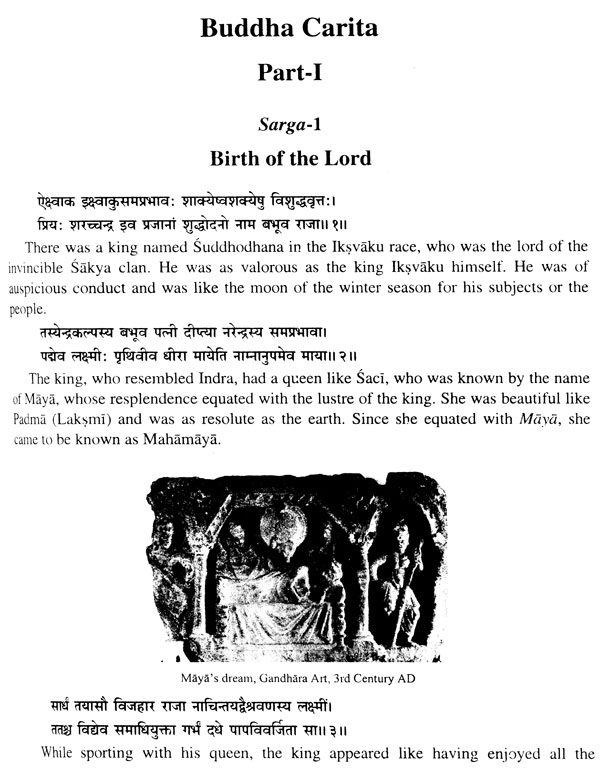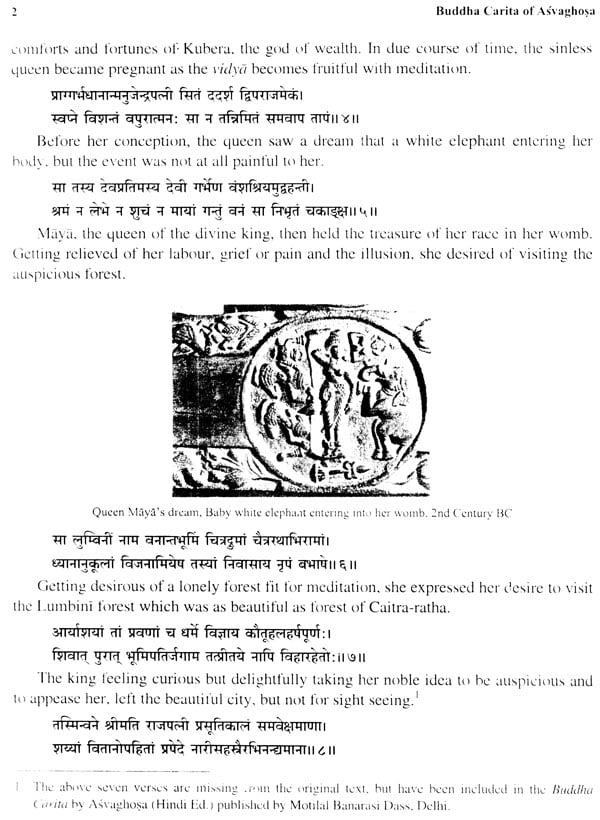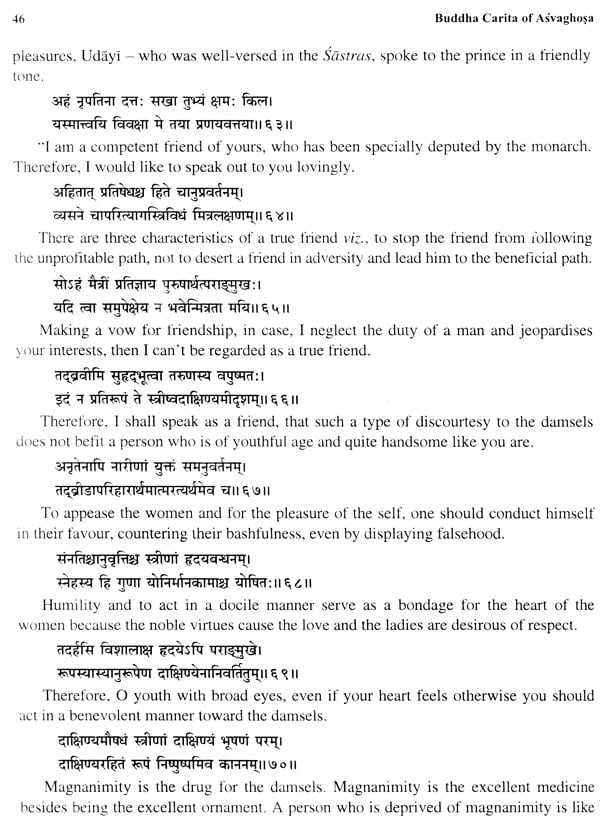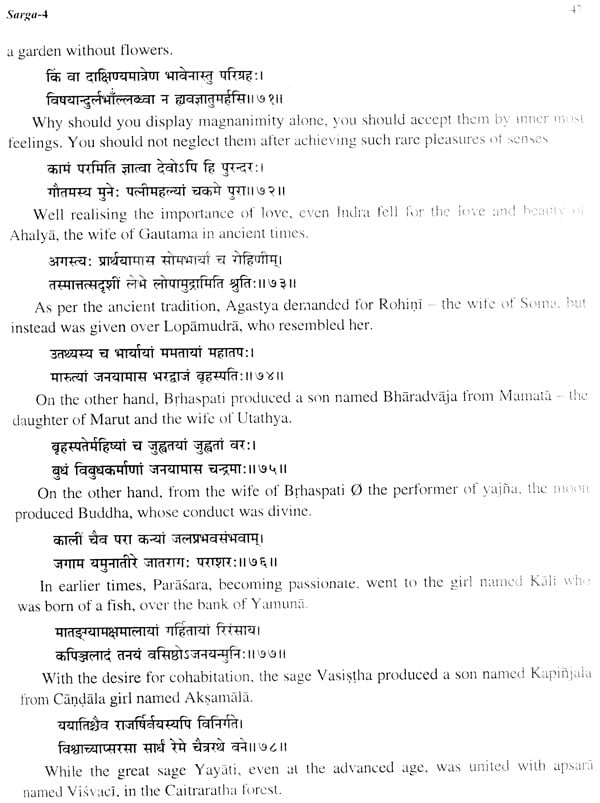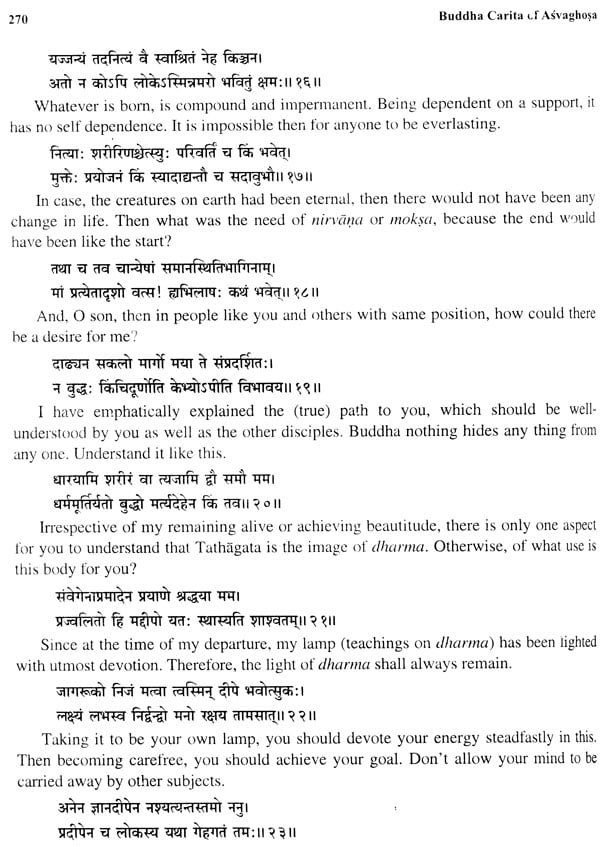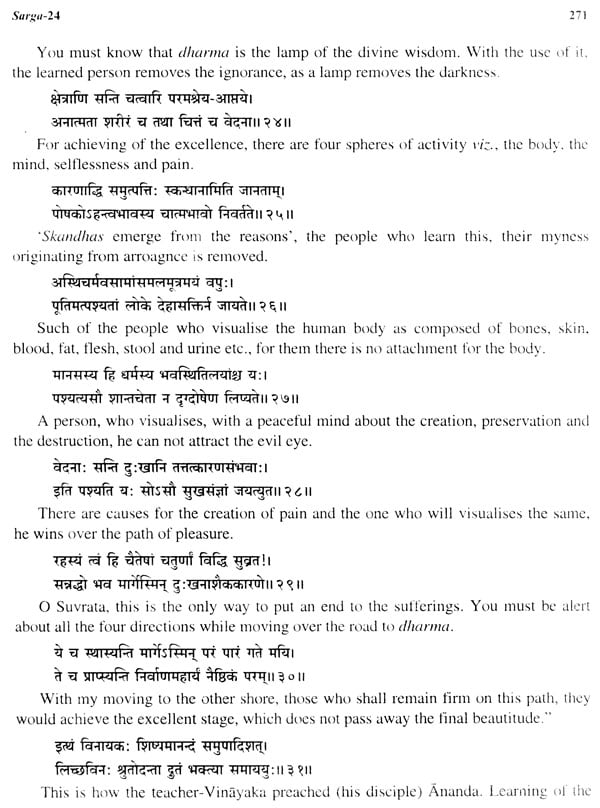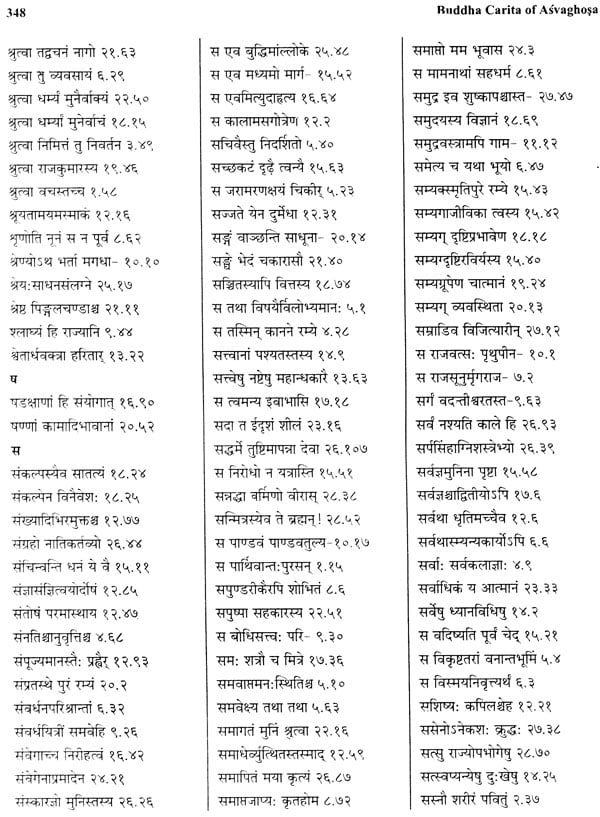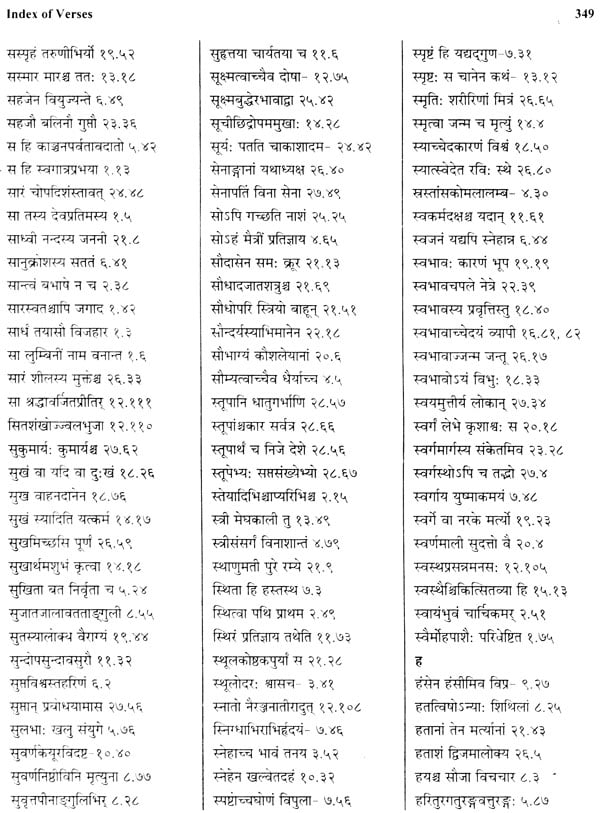
Buddha Carita of Asvaghosa
Book Specification
| Item Code: | NAC441 |
| Author: | Shanti Lal Nagar |
| Publisher: | Parimal Publication Pvt. Ltd. |
| Language: | (The Only Edition with Both Sanskrit Text and English Translation) |
| Edition: | 2020 |
| ISBN: | 8171103944 , 9788171103942 |
| Pages: | 360 (Illustrated In B/W) |
| Cover: | Hardcover |
| Other Details | 9.8 Inch X 7.5 Inch |
| Weight | 910 gm |
Book Description
In the Indian cultural horizon, Buddha had a distinctive personality. He was the founder of Buddhism. In Hinduism, he has been believed to be an incarnation of Visnu.
The learned scholars have come to conclusions that Gautama Buddha was born in BC 560 in Kapilavastu near the Himalayas, to the king Suddhodhana of the Sakya clan. The word Sakya is another form of ksatriya. The real name of Buddha was Siddhartha. He spent his childhood in comfort and pleasure.
Once he happened to see a sick man, an old man and a dead body, the sight of which erode the innocent child quite thoughtful. He, therefore, began to think upon a way to remove the sufferings and pain from the world, bringing about peace and comfort to one and all.
Siddhartha wandered from place to place alone learning from various teachers, but the mental peace still eluded him. Once on a full moon day, while he was still in meditation under a banyan tree, he got enlightenment. From that day onwards, he came to be known as Buddha.
Buddha Carita is a poetic marvel by the great poet Asvoghosa which depicts entire life sketch or biography of Buddha in an exhaustive manner. This epic comprises of twenty eight sargas in which the life and teachings of the Buddha have been brought out. It was translated into Chinese in the seventh century AD and was subsequently translated into the Tibetan language.
The present edition of Buddha Carita is the first of its type that includes Sanskrit text, side by side English Translation and also photographs of archaeological importance at appropriate places in the text itself. At last, an index of Sanskrit verses is also provided for the benefit of the readers and researchers.
The Translator
He is a graduate of the Punjab University and served the Archaeological Survey of India and the Ministry of Home Affairs, for over four decades in curatorial and other capacities. He has to his credit the scientific documentation of over fifty thousand are objects/antiquities comprising of sculptures, bronzes, paintings, pottery, beads seals and railings etc. Ranging from the earliest times to the late medieval period. He was bestowed with an award by the Government of Himachal Pradesh in 1983, for his monograph on the Cultural Heritage o the State. He was awarded a fellowship for his literary work on Temples of Himachal Pradesh during 1987-89 by the Indian Council of Historical Research, New Delhi.
He was bestowed with the Anuvadasri award for 2007-2008 by the Bharatiya Anuvada Pariad, New Delhi.
He has been associated with the Govt. of Sikkim as a Spiritual Consultant for the setting up of Sculptures in the Siddhesvara Dhama Cultural-cum-Tourist Complex at Solophok, Namchi, South Sikkim for over four years.
In the Indian cultural horizon, Buddha had a distinctive personality. He was the founder of Buddhism. In Hinduism, he has been believed to be an incarnation of Visnu. Accordingly, it is believed that in ancient times, there had a battle between the devas as well as the asuras in which the former were defeated by the asuras and the vanquished devas approached Visnu carrying the tale of their plight, at the hands of the asuras. Assuring the gods, lord Visnu incarnated on earth as the son of Suddhodana with the name of Siddhartha or Gautama Buddha. Then he went to the asuras and made them reject the holy Vedas and the related laws. The daitvas or asuras then followed the teachings of Buddha. There is a story as told in the Agni Purana, Chapter-16, that thus it was the purpose of Buddha to convert evil soul to Buddhism and send him to hell. This is the Pauranika view.
But further investigations by the learned scholars have come to conclusions that Gautama Buddha was born in BC 560 in Kapilavastu near the Himalayas, to the king Suddhodhana, of the Sakya clan. The word Sakya is another form of ksatriya. The real name of Buddha was Siddhartha. Suddhodhana brought up his son in such a way that he could not be subjected to any sort of mental pain or sufferings. He was therefore, kept aloof from the outer world. He, therefore, spent his childhood in comfort and pleasure.
Once he happened to see a sick man, an old man and a dead body, the sight of which erode the innocent child quite thoughtful. He therefore, began to think upon a way to remove the sufferings and pain from the world, bringing about peace and comfort to one and all.
The change that appeared in the son, made the monarch quite auspicious. Therefore, at the age of sixteen, Siddhartha was married to Yasodhara. In due course of time, a son was also born to the royal couple. But the mind of Siddhartha continued to be restless, distressed and agitated. One day, Siddhartha discarded all the royal pleasures including his wife and only child and went out of the palace alone.
Siddhartha wandered from place to place, alone learning from various teachers, but the mental peace still eluded him. Once on a full moon day, while he was still in meditation under a banyan tree, he got enlightenment. From that day onwards, he came : be known as Buddha. Thereafter, he reached the city of Kasi and revealed to his disciples, the manner in which he got enlightenment. Thereafter, the number of his followers was increased day by day and Buddhism was established. Buddha preached that the reason for pain or suffering in human life was the desire and the sorrow could be put to an end by overcoming all the desires. In order to attain the Eternal bliss, one should be free, righteous in his actions, thought and the coronet. Besides Ahimsa was the basis of the righteousness. In due course of time, Buddhism spread almost throughout the world. Buddha got his Parinirvana at the age of eighty years.
In fact, there had been two main personalities connected with the literary work of great eminencies of the remote past. One of them is the Buddha whose biography has been brought out and the other one is Asvaghosa—the great poet of the remote past. The brief of the life of the Buddha has been provided above and now the performance of the great poet Asvaghosa is discussed hereunder.
Of the numerous poets of Sanskrit of the ancient past, Asvaghosa is the one about whose time, there is no controversy among the scholars. The Buddhist literature has preserved the related information about the time and the creations of Asvaghosa. Not only that, the literary creations of Asvaghosa have also been preserved by the Buddhist establishments in the form of the original texts or their translations, the Buddhist traditions have also included several other literary creations which were not composed by him, as his creations as well. In spite of all this, it is certain that Asvaghosa was contemporary of the emperor Kaniska. According to the Chinese tradition, Asvaghosa had been the preceptor of the emperor Kaniska. Some scholars are of the opinion that Asvaghosa was the propounder of the Mahayana school of Buddhism, while others contest this theory. But this is certain, that Asvaghosa played a significant role in the spread of Mahayana doctrine of Buddhism. This aspect is supported by the literature produced by Asvaghosa.
Asvaghosa was the son of Svarnaksi and was born at Saketa. The titles of Arya, Bhadanta, Mahavadin and Maharaja were used for him. Asvaghosa lived earlier to Nagarjuna, whose name appears in the Stupas at Jagayyapitta, which was got engraved by his disciple during the 3rd century AID. On the basis of the said epigraph, the tale of Nagarjuna has been taken to be the 2nd century AD Asvaghosa lived at least two generations earlier than Nagarjuna, close to the time of Kaniska or contemporary of Kaniska. He composed several works in Sanskrit, details of which are given below—
(I) Buddha Carita—
This epic comprises of twenty eight sargas in which the life and teachings of the Buddha have been brought out. It was translated into Chinese in the seventh century AD and was subsequently translated into the Tibetan language. Itsing—the Chinese traveller has described it as a vast work, but there are only seventeen chapters in the Sanskrit text. The rest of the chapters were added subsequently on the basis of the Tibetan and Chinese translation of the same.
(ii) Saundrananda—
This epic has been composed in eighteen sargas. Two manuscripts of this epic are preserved in the National Library of Nepal, which were published by Har Prasada Sastri. It contains the story of Nanda and Sundari, the royal couple, who were immensely attached to each other. Nanda was a Sakya prince, who was converted as a monks by the Buddha. He did not receive ordination of his own accord, but he did so in order to avoid displeasing the Buddha. He therefore, did not practise the religious exercises required of a monk but he kept himself away from such exercises, because he was immensely attached to his beautiful wife known as Sundari. In order to detract the mind of Nanda from Sundari and to lead him the path of dharma, Buddha, with his spiritual powers took Nanda to heaven where he drew the attention of Nanda to a she-monkey who was blind of one eye. Buddha asked Nanda as to what did he think about the she-monkey in comparison to his wife. Nanda replied that there was as much difference between the nymph and Sundari as it was between the nymphs and Sundari, as there was between the latter and the monkey. Nanda was then desirous of the nymphs. Then the Buddha advised him to perform the religious exercises in the righteousness, which he did.
(iii) Sariputra Prakarana—
This was a work of nine chapters, which highlights the life of common man of the contemporary society including the whores, criminals, slaves and slave girls.
Besides the above, several other works are assigned to Asvaghosa, but some scholars have contented the same. I am deeply indebted to the Mahabodhi Society of Saranatha (Varanasi) for their kind gesture for making available some photographs on the life of the Buddha, which have surely added grace to the work.
| Preface | v-vii | |
| Part-I | ||
| Sarga-1 | Birth of the Lord | 1-17 |
| Sarga-2 | Activities of Inner Apartment | 18-27 |
| Sarga-3 | The Disturbed Prince | 28-37 |
| Sarga-4 | Rejection of Damsels | 38-81 |
| Sarga-5 | Deserting the Home | 52-65 |
| Sarga-6 | Sending off Chandaka | 66-75 |
| Sarga-7 | Entry into the Forest Grove | 76-84 |
| Sarga-8 | Lamenting in the Inner Quarters of the Palace | 85-97 |
| Sarga-9 | Search for the Prince | 98-110 |
| Sarga-10 | Arrival of Bimbasara | 111-117 |
| Part-II | ||
| Sarga-11 | Denouncing of Lust of Passion | 118-12 |
| Sarga-12 | Visit of Arada | 130-146 |
| Sarga-13 | Victory over Mara | 147-159 |
| Sarga-14 | Buddha’s Enlightenment | 160-170 |
| Sarga-15 | Turning the Wheel of Law | 171-182 |
| Sarga-16 | Many Disciples | 183-195 |
| Sarga-17 | Invitation of the Great Disciples | 196-202 |
| Sarga-18 | Invitation of Great Anthapinda | 203-215 |
| Sarga-19 | Meeting of the Father and the Son | 216-225 |
| Sarga-20 | Donation of Jetavana Accepted | 226-237 |
| Sarga-21 | Source of Renunciation | 238-248 |
| Sarga-22 | Visit to Orchard of Amrapali | 249-256 |
| Sarga-23 | Fixing the Span of Age | 257-267 |
| Sarga-24 | Showering of Grace on Licchavis | 268-276 |
| Sarga-25 | On Way to Nirvana | 277-288 |
| Sarga-26 | The Great Departure | 289-304 |
| Sarga-27 | Praise of Nirvana | 305-316 |
| Sarga-28 | Distribution of Relics | 317-327 |
| Index of Verses | 329-350 |
